![What Is Ringing in Audio? [Definitive Guide]](jpg/ringing-audio-artifact-720.jpg)

If you buy "AuI ConverteR PROduce-RD" (2023/12.x version) from 24 August 2023 to 24 October 2023, you will get free update to version 2024 (13.x) after its release.
![video: How to improve sound quality [Your Guide]](jpg/sd--nk1n7im1vky.jpg)
Back to top
What is ringing audio
Encountering ringing in audio can be a curious experience. Digital-to-analog converters (DACs), along with other music equipment and software, utilize sound filters such as EQs and others. These are digital signal processing (DSP) algorithms and analog electrical circuits.
Audio ringing is an artifact that emerges from the output of audio filters, triggered by the input signal. These artifacts manifest as damped oscillations, akin to ripples fading away on water. Both analog and digital filters cause ringing distortions.

The standard test signal for assessing ringing is the delta pulse, also known as the Dirac delta function. In theory, this is a signal with an infinitely high amplitude over an infinitesimally short duration. For digital systems, this translates to a single sample at maximum amplitude.
Analog systems, on the other hand, use a test pulse with the shortest possible duration, approaching zero.
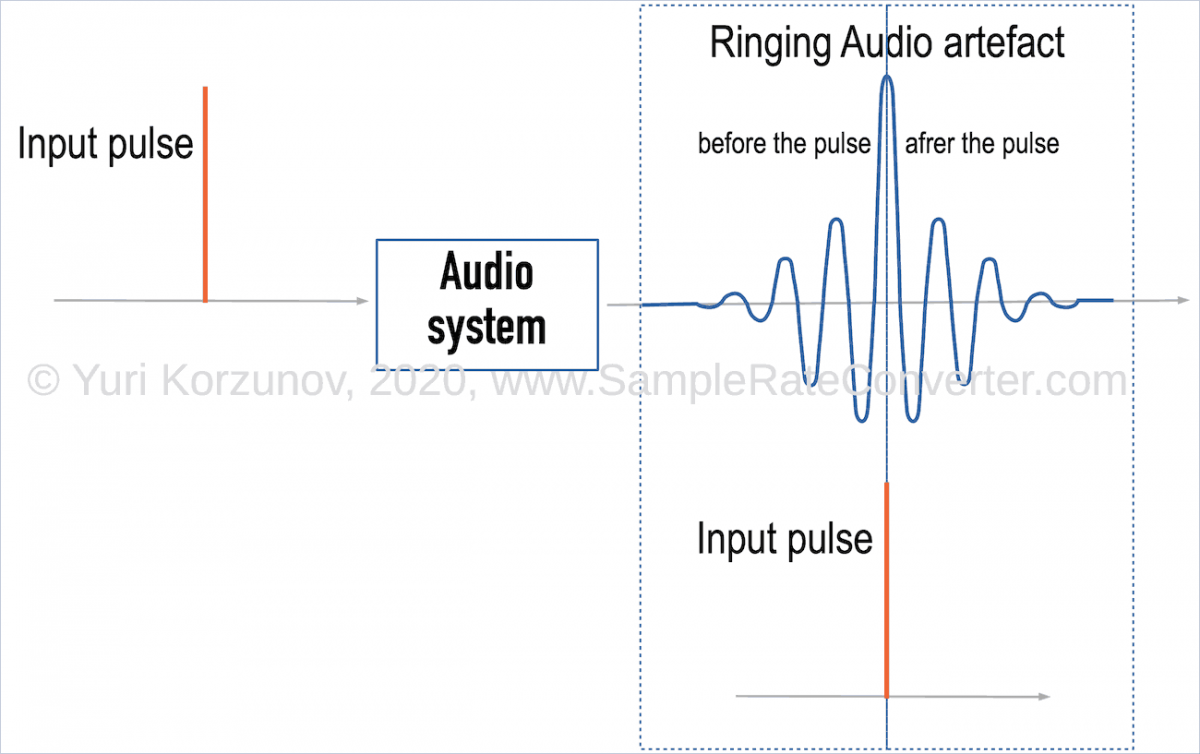
Ideally, the output signal should mirror the input. However, due to digital filters and feedback within the system, this is not always the case.
What is pre-ringing in audio?
Imagine a conveyor belt at airport security. Place a glass cube on the belt, and ideally, it exits unchanged. That's our perfect system. But if the cube encounters a drum stick inside. We listen to sound, but can't see the cube. Later the cube exits. It is visible and sounds some time. This analogy illustrates the unintended oscillations, or ringing, that occur in practical audio systems.
Following the input pulse, we observe post-ringing, similar to an echo. Conversely, pre-ringing occurs before the pulse, resembling a pre-echo. It precedes the sound which invokes the echo.
What is the ringing frequency?
When a single-sample pulse hits a filter, oscillations ensue. The ringing frequency is the frequency of these oscillations. The filter's magnitude-phase response to an input sound wave determines the oscillation frequency.
Ringing in audio is characterized by high-frequency oscillations. During digital-to-analog conversion and resampling of common audio sample rates, the ringing frequency typically falls within the ultrasound range.
Back to top
How digital filter works

At the heart of audio clarity, a digital filter can be both a culprit and a craftsman. Its role in causing ringing signals is pivotal.
The process is sequential:
- The filter receives a series of digital audio samples, the lifeblood of sound processing.
- Each sample is then adjusted with a precise gain, shaping the audio's character.
- The culmination of these adjustments forms a single output sample, ready for the listener's ear.
Viewing the filter as a singular unit, it's a gateway: one sample inputs, and one sample outputs. A digital signal enters, transformed, it exits.
In reality, the filter grasps multiple samples, weaving them into a sonic tapestry.
Subsequently, the filter:
- Advances one sample forward, continuing the audio journey.
- Repeats the initial steps, ensuring a continuous output.
Thus, the filter's inputs glide along the input signal's samples.

Back to top
Linear phase filter
A linear phase filter calculates its output by considering multiple input samples before and after current time. The peak output amplitude occurs when the one-sample pulse aligns with the filter's center.

Time N marks the maximal pulse's ascent at the output.
Pre-ringing
The filter has several inputs for part of the coming sample sequence. In the picture above, at the initial time of 1, the pulse sample arrives at the leftmost input with minimal gain. This triggers a subtle output level—a foreshadowing of the pulse’s full impact that will coming later.
This phenomenon, where the output level precedes the pulse's peak moment (time N), is known as pre-ringing.
Post-ringing
Post-ringing is the aftermath. As the pulse traverses from the center towards the rightmost input with diminishing gain, it leaves behind a trail of oscillations.
These persist even after the pulse's prime moment at the output (time N), a ghostly whisper of the original signal.
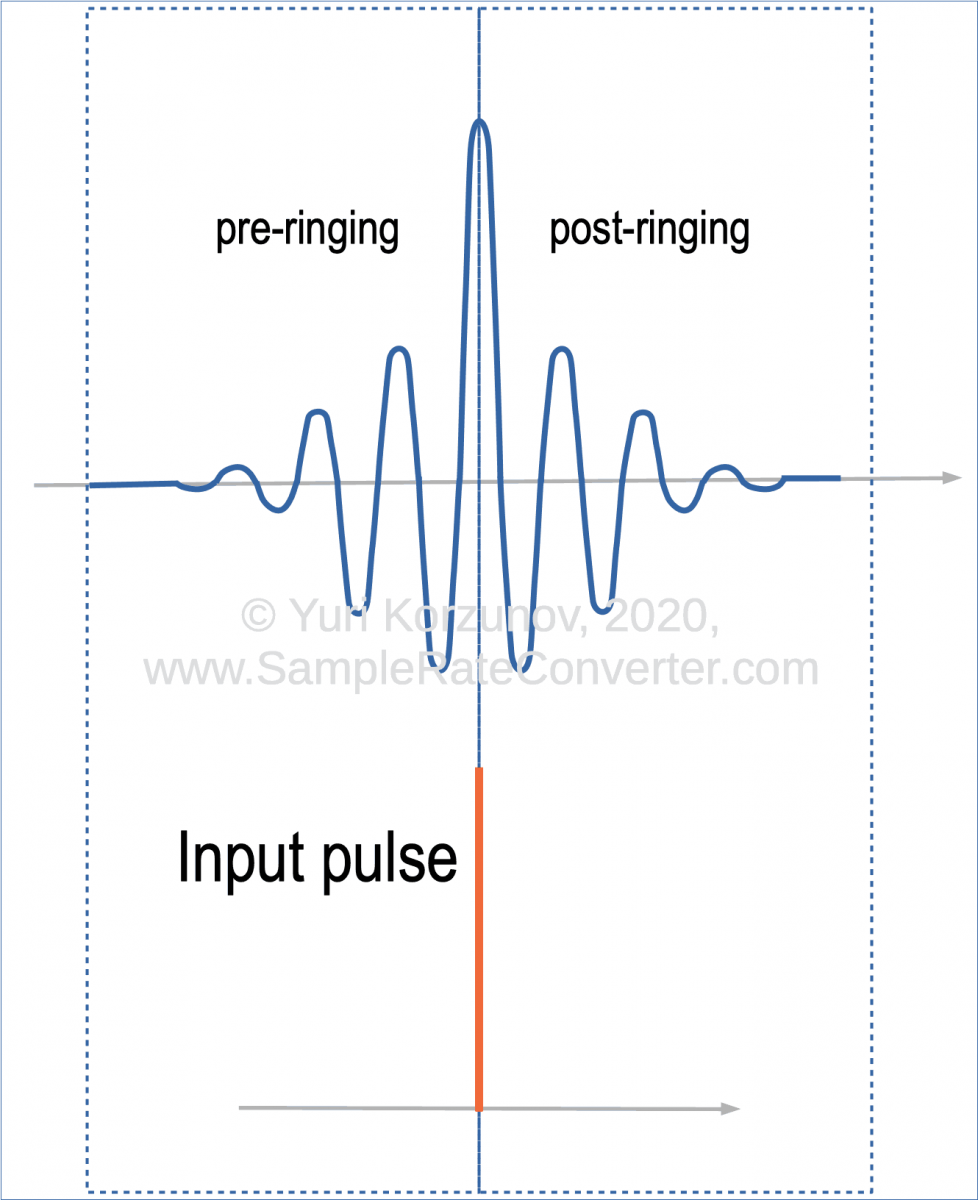
Back to top
What are minimum phase filters?
In the analog realm, pre-ringing is not a challenge. For digital filters, it’s the ghost of a signal yet to arrive. To address this, the minimum phase filter has emerged as a solution.
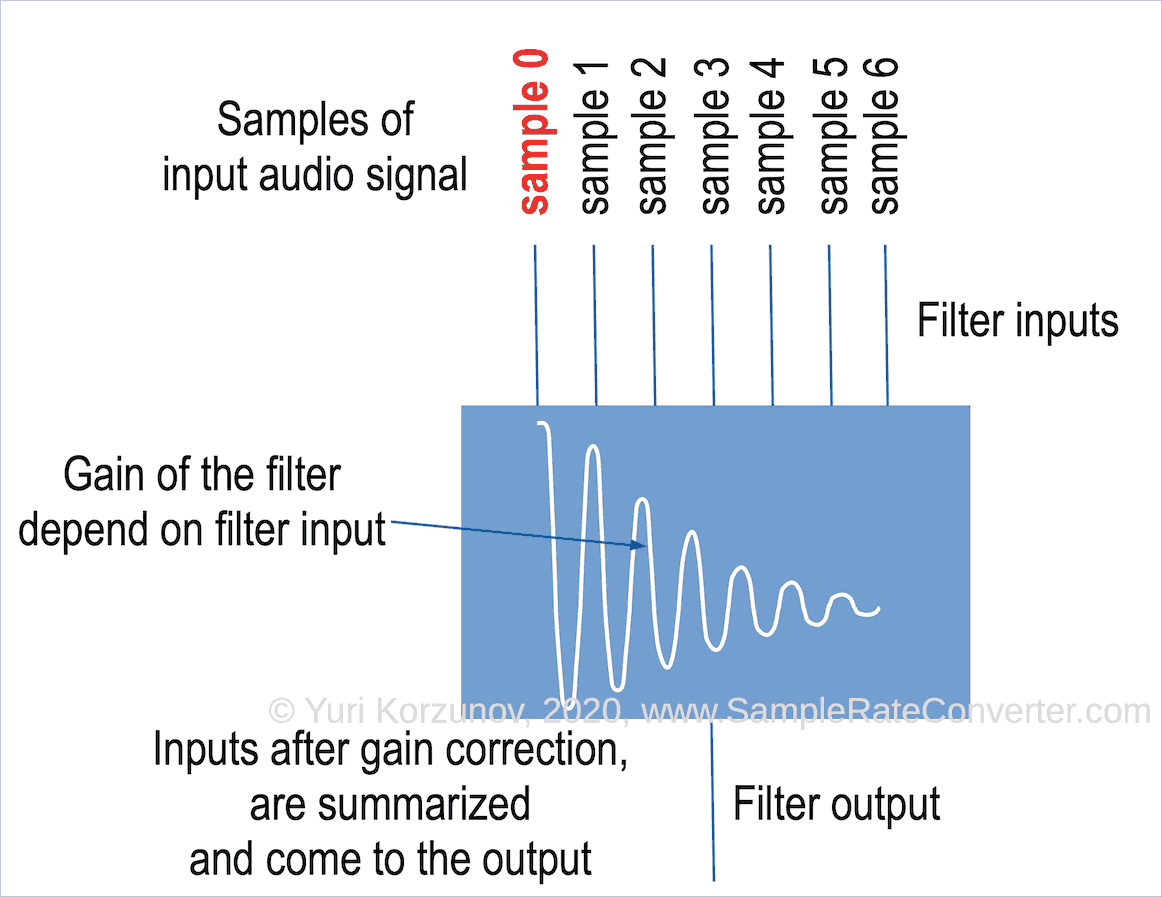
Yet, even the minimum phase filter comes with its own set of complexities.
Comparing Minimum and Linear Phase Filters
When it comes to minimum phase vs linear phase filters, each has its unique characteristics:
| Linear | Minimum Phase | |
|---|---|---|
| Magnitude-frequency response | Identical for both | |
| Phase-frequency response | Linear | Non-linear |
| Pre-ringing | Present | Absent |
| Post-ringing | Present | Present |
| Post-ringing energy | Higher than linear phase filter | |

The minimum phase filter introduces a non-linear phase within the passband, with the degree of non-linearity varying based on the filter's design and implementation.
Back to topInterpreting ringing in relation to magnitude-frequency response
Consider the ubiquitous low-frequency (low-pass) filter in audio systems, which shares properties with other filter types. It features a passband for low frequencies and a stopband for higher ones, separated by a transitional band.

To preserve the signal's integrity post-resampling, an ideal transient band would have zero width. However, achieving this requires an increased number of taps, which in turn extends the duration of ringing effects. It's illustrated in "ringing audio of linear phase filters". This holds true for both linear and minimum phase filters.
An audio system with a flat amplitude-frequency response from 0 to infinity Hz would exhibit no ringing.
Resampling filters, crucial in many sampling rate conversion algorithms, must balance artifact rejection with minimal loss of passband width. To achieve this:
- The filter should have the narrowest possible transient band.
- This band must remain below half the sampling rate for optimal performance.
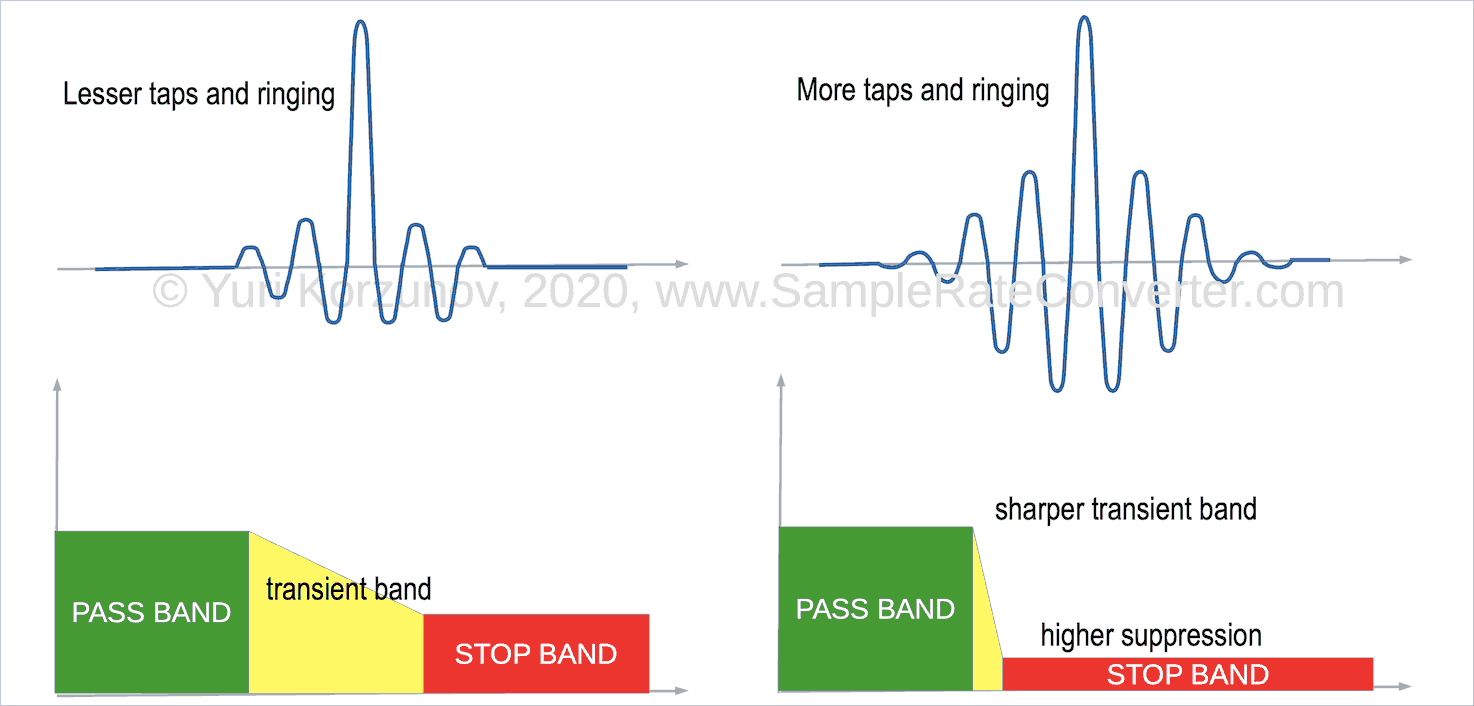
The transient band's sharpness, determined by the stopband's suppression level. It directly influences the distortion within the useful band after resampling. This band includes the audible range. A filter with a sharper transient band will inherently possess a higher energy of ringing oscillations beyond the input pulse's timing.
NOTE: Bandwidths in digital filters are relative. Typically, the total bandwidth is normalized to 1.0, with specific bandwidths ranging from 0.0 to 1.0. 1.0 is is half of sampling rate. Importantly, the widths and the length of ringing (measured in samples) are independent of the sample rate.
Assessing Sound Quality and Ringing Artifacts
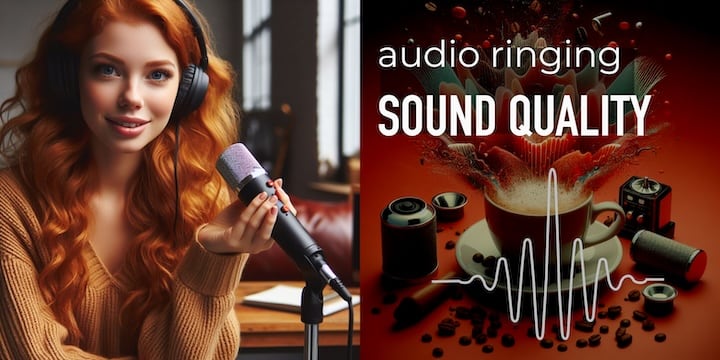
Discussions on the real-world impact of ringing in audio on sound quality are sparse, with few rigorous studies to reference. The visual impact of ringing on a pulse response plot may seem daunting, but the actual effect on sound quality is often less dramatic.
Is pre- and post-ringing audible?
Theoretically, the part of ringing progucts may penetrate into high frequencies of audible range.
To produce noticeable ringing, the variation between adjacent samples must approach the maximum possible value. However, this scenario is rare. Typically, low levels of ringing are present.
For instruments with sharp attacks like pianos, guitars, and drums, ringing might become perceptible.
How to reduce the ringing?
High-resolution audio allows for a broader transient band, maintaining artifact suppression within the audible range. With human hearing capped at 20 kHz, high-resolution formats extend beyond. It's allowing filters to begin their transition band at 20 kHz to half of high sample rate.
Utilizing a higher sampling rate can soften the transient band's sharpness, reducing the number of taps and subsequently, the level of ringing.

The Role of Apodizing Filters in Reducing Ringing

Combatting ringing within filter circuits is a key concern. Apodizing filters stand out as they aim to deliver an output free from multiple oscillations (but ringing still here).
Yet, this improvement comes with a trade-off: reduced transient band sharpness, which could lead to audible aliasing. High-resolution audio formats may mitigate this sharpness-alias issue.
Apodizing oscillation is present from low frequencies. Ordinary ringing consists of up to several samples per period, which means that ordinary ringing primarily occurs in the higher frequencies inside the inaudible ultrasound range.
Back to top
Conclusions

Ringing is an inherent artifact in digital filtering, and the solution lies in optimizing filters to balance:
- Minimized ringing;
- A narrow transient band for a required passband;
- Sufficient stopband suppression.
While comprehensive research on ringing's impact on sound quality is lacking, it's generally accepted that for most musical signals, ringing levels fall below the noise floor and are thus inconsequential.
In the broader context of audio device and software design, reducing ringing is often advised to ensure the highest sound quality.
Back to top
Frequently Asked Questions

What causes ringing in a circuit?
In electrical and electronical circuits, all conductors (wires) have physical sizes. It causes unwanted capacity and inductance. It may cause ringing for transient processes (oscillations or "the ringing") when electrical voltage in the circuit is changed.
Which filter has ringing effect?
Any filter has transient processes at its output when input signal is changed. In instance, input sine changes amplitude or frequency.
However, pre-ringing is digital filter feature only.
Read more...
What is ideal low-pass filter?
Ideal low-pass filter is so-called "brickwall" filter. Such filter has no transient band.
If you want to reduce ringing energy, you're need to expand transient band.
Read more...
What causes ringing in a circuit?
In electrical and electronic circuits, all conductors (wires) possess inherent physical dimensions. These dimensions contribute to unwanted capacitance and inductance, which can lead to ringing—oscillations or "the ringing"—during transient processes when electrical voltage in the circuit changes.
Which filter has a ringing effect?
Transient processes at the output of any filter (low-pass, high-pass, band-pass) occur when the input signal changes, such as when an input sine wave alters its amplitude or frequency. However, pre-ringing is a characteristic unique to digital filters.
Read more...
What is an ideal low-pass filter?
The ideal low-pass filter, often referred to as a "brickwall" filter, has no transitional band. To diminish the energy of ringing, it's necessary to broaden the transitional band.
Read more...
Does EQ affect phase?
Equalizers (EQ) can affect the phase of audio signals. Traditional EQs, especially analog ones, often introduce phase shifts as they alter the amplitude of various frequencies. However, linear phase EQs are designed to minimize this effect.
What is linear phase EQ?
A linear phase EQ is a type of equalizer that aims to maintain the phase relationships of different frequencies while it adjusts their amplitudes. This prevents the smearing of transients and preserves the original timing of the audio signal.
What is the ringing effect?
The ringing effect refers to the oscillations that follow a transient in an audio signal. It's often seen after sharp, sudden sounds and is a result of certain filter characteristics in digital signal processing.
What is digital ringing?
Digital ringing is the term used to describe the oscillations or 'ringing' that occur in digital audio processing, typically as a result of applying sharp filters like those used in sample rate conversion.
What is ringing in a filter?
Ringing in a filter refers to the phenomenon where filters cause oscillations around sharp transients in the audio signal. These are more pronounced in filters with steep slopes, such as brickwall filters.
What is the difference between ringing and aliasing?
Ringing is the oscillation that follows a transient, while aliasing is a type of distortion that occurs when high frequencies are improperly sampled and mirrored into the audible range. Both are unwanted artifacts in digital audio processing. Read more about the aliases.
- What is Jitter in Audio. Sound Quality Issues >
- 64-bit audio processing. Necessity or redundancy >
- What is Audio Converter >
- How to Choose the Best Audio Converter Software >
- What is dithering audio? >
- Bit-Depth Audio and Harmonic Distortions >
- Audio as Optics >
- What is optimization audio for DAC >
- Where is the Limit of Audio Quality? >
- Power Conditioner for Audio. It's real advantage? >
Audio Basis - articles about audio
Back to top